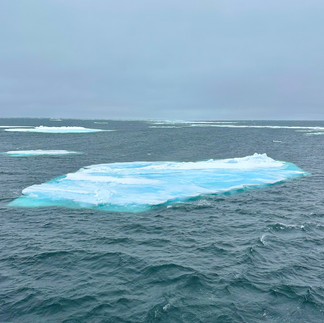Today we were on the hunt for polar bears so this morning headed north and sailed through the 80º north latitude which placed us about 600 miles from the North Pole and to the edge of the polar pack ice. We encountered plenty of colourful Arctic sea ice, some are a vivid blue because the red (long wavelengths) part of white light is absorbed by ice and the blue (short wavelengths) light is transmitted and scattered. The longer the path light travels in ice, the more blue it appears. Pieces of sea ice are known as floes.These floes are prone to converge, or bump into each other, and pile up into thick ridges. These converging floes make Arctic ice thicker the Antarctic ice. Since ice tends to stay within the Arctic, it can survive longer and continue to thicken in its cold conditions. The presence of ridge ice and its longer life cycle leads to ice that stays frozen longer during the summer melt. So, a significant proportion of Arctic sea ice remains through the summer and continues to grow the following autumn. Of the 15 million square kilometres (5.8 million square miles) of sea ice that exist during winter, on average, about a third remains at the end of the summer melt season. Apart from a couple of seals (the polar bears preferred meal) we couldn't find the elusive bear so headed back to Raudfjord Svalbard to see if we would have better luck. Into a beautiful Fjord for the afternoon - spotted two deer and followed up by a concert on the helicopter deck.
top of page
bottom of page












So interesting about ice colour. And how amazing to experience. Concert in such a place incredible